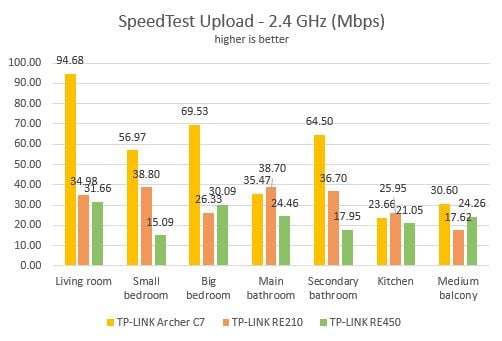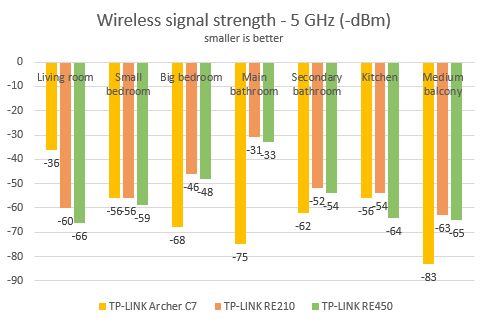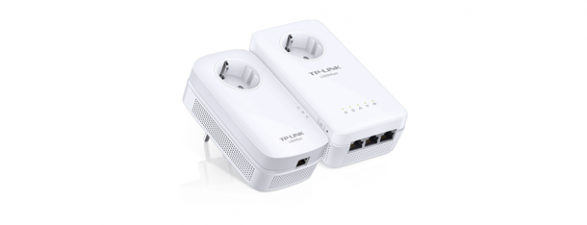
Performance in benchmarks
Below you have a diagram of how our test apartment is set up. It is a reasonably large apartment and, if you don't have very good router, the wireless coverage can get rather weak in rooms like the kitchen or the medium balcony which are far away from it. You can see that we have placed the router in the living room and the range extender in the hallway. The router that we used is TP-LINK Archer C7. We mounted the range extender on the hallway, to improve the wireless coverage in the rooms that are farther away from the router.
When making our measurements, we compared TP-LINK RE450 with TP-LINK RE210 (it's smaller brother in terms of price and specifications). In the graphs below, you will see the performance offered by these two range extenders, alongside that of the router we used: TP-LINK Archer C7. As you will see for yourself, range extenders are not able to offer the same speed as a router does, at least not in those rooms where the router has excellent coverage. The idea is to understand what kind of coverage and speed a range extender can offer in areas where the router doesn't manage to provide good coverage.
We started by evaluating the 2.4 GHz wireless network and the signal strength of this network, using a tool named inSSIDer. As you can see below, the signal strength offered by TP-LINK RE450 was generally better than that of its more affordable brother - TP-LINK RE210.
Then, we used SpeedTest to see how fast the Internet connection is when using the 2.4GHz wireless network. As you can see below, TP-LINK RE450 was faster than TP-LINK RE210 in most rooms, but not by a lot.
Unfortunately, when measuring the upload speed with SpeedTest, TP-LINK RE450 was outperformed by its more affordable brother.
For the next test, we used LAN Speed Test Lite to measure the download and upload speeds when transferring a 350MB file on the wireless network. In terms of download speed, the results we measured were very close between the two range extenders we compared: TP-LINK RE450 and TP-LINK RE210.
Unfortunately, the upload speed seems to be a weak spot of the new TP-LINK RE450, which was outperformed again by its more affordable brother.
When it comes to extending 2.4 GHz wireless networks, TP-LINK RE450 offers good download speeds but rather slow uploads.
We moved on to evaluating the 5GHz wireless network and the signal strength of this network, using inSSIDer. As you can see below, the signal strength offered by TP-LINK RE450 was slightly worse than that of TP-LINK RE210.
Unfortunately, this translated into the uneven performance when measuring how fast the Internet connection was, using SpeedTest. As you can see below, the download speed offered by TP-LINK RE450 was great in some rooms and very weak in others.
Fortunately, performance improved when measuring the upload speed with SpeedTest. Here, TP-LINK RE450 tended to outperform TP-LINK RE210.
For the last round of measurements, we used LAN Speed Test Lite to measure the download and upload speeds when transferring a 350MB file on the wireless network.
The download speed offered by TP-LINK RE450 was similar to that observed when using SpeedTest. The TP-LINK RE450 range extender was rather inconstant in its performance.
Again, when looking at the upload speed, the situation improved.
When extending 5 GHz wireless networks, TP-LINK RE450 is rather inconsistent. Depending on the setup of your home or office, in some rooms, it may deliver fast transfers while in others it won't help at all.
Extra features
TP-LINK RE450 AC1750 offers very little in terms of extra features:
- Access Control - a feature that allows you to blacklist or whitelist devices that can access the wireless networks that are broadcasted by the range extender.
- LED Control - a feature that allows you to set the time interval when the LEDs on the range extender are off.
TP-LINK RE450 AC1750 doesn't bundle much in terms of extra features. It's firmware sticks to the basics that are required in order for a range extender to do its job.
Verdict
The TP-LINK RE450 AC1750 range extender stands out through its size, aspect, specifications, and price. It's a rather expensive range extender that promises to deliver good coverage and fast wireless transfers. Unfortunately, it's performance is a bit uneven. In some areas of your home or office, you might get very good coverage from this range extender, while in others it will be disappointing. Other range extenders, including the more affordable TP-LINK RE210, are able to deliver more consistent results, even though they won't be as fast as TP-LINK RE450 AC1750.


 26.02.2016
26.02.2016 














